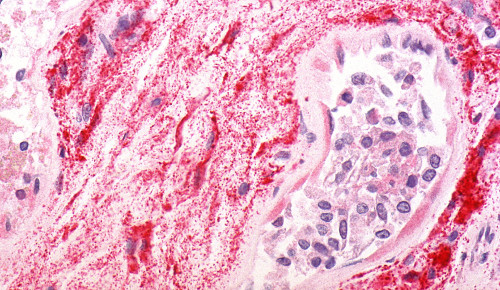There’s a nexus between the index cases (the first people infected by Ebola virus) and deforestation, especially close to forest margins fragmented and disturbed. In these cases, human populations can be particularly exposed to ebolaviruses infections because of the higher likelihood for humans to be in contact with disease reservoirs. The analyses of a study published on “Scientific Reports”, a journal of the Nature Publishing Group, realized by an international research team. Among them, Monia Santini from the CMCC Foundation.
Eleven infection events from 2004 to 2015, eleven index cases analyzed, that is the first eleven human beings to be infected by Ebola virus. Different geographic areas in Central and West Africa, and in particular in Guinea, South Sudan, Rep. of Congo, Democr. Rep. of Congo and Uganda. All these centers of first infection of Ebola virus disease in humans have something in common: deforestation, that is forest destruction, land use changes and a landscape strongly reshaped by tree plantations and other human activities.
In other words, the areas in which we recorded the first virus disease outbreaks from 2004 to 2015 are hotspots of forest fragmentation. Forested areas affected by deforestation and fragmentation that create an irregular, non-linear forest boundary with non-forest cores. The extent and irregularity of this boundary causes a higher likelihood for humans to be in contact with disease reservoirs.
These are the results of a research published on “Scientific Reports“, a journal of the Nature Publishing Group, entitled “The nexus between forest fragmentation in Africa and Ebola virus disease outbreaks“. The study has been coordinated by Maria Cristina Rulli (Department of Civil and Environmental Engineering, Politecnico di Milano, Milan, Italy) and among its authors there’s also researcher Monia Santini of CMCC Foundation – Euro-Mediterranean Center on Climate Change, and researchers of Massey University (New Zealand) and University of California, Berkeley (CA, USA).
“We analyzed the impact of forest loss (and the impact of different types of deforestation) on these virus disease outbreaks – explains Monia Santini, researcher at the CMCC Scientific Division IAFES – Impacts on Agriculture, Forests and Ecosystem Services at Viterbo Headquarters.”We found out that the centers of first infection were not located in areas where the average degree of deforestation was significantly higher than the average for Central Africa”.
The difference concerned the type of deforestation. The eleven areas where occurred the first index cases are characterized by a significantly higher degree of forest fragmentation and this enhanced the probability of a contact between infection reservoirs, such as some frugivorous and insectivorous bat species, and humans.
“Our study – says Santini – is a statistical analysis focused on land use change and landscape analyses in the surroundings of these eleven centers of first infection. We use high-resolution forest data from satellites to study landscape and to allow evaluation of changes in forest cover and forest fragmentation prior to each outbreak. In this way we found out that the centers of first infection tend to occur in areas where on the outbreak year the average degree of forest fragmentation was significantly higher than the average degree of forest fragmentation across the region”.
In conclusion, not only exists a clear nexus between the spread of the Ebola virus and the deforestation in West and Central Africa, but also this link seems to become evident with a particular type of non-linear, fragmented deforestation which leads to a wider interface with areas affected by land use change, for example from forest to agricultural use. In fact, while the elimination of trees and forests destroys the habitat of some species, there are other, like the bat one, that was identified to be an Ebola virus vector, that crowds the borders of forests. Therefore, increasing the extent of the boundary between forest and areas affected by land use changes, could create a kind of preferential corridors for wildlife animals that might be responsible for the virus transmission.
Rulli, M. C. et al. The nexus between forest fragmentation in Africa and Ebola virus disease outbreaks. Sci. Rep. 7, 41613; doi: 10.1038/srep41613 (2017)
http://www.nature.com/articles/srep41613
Info and contacts: Mauro Buonocore – CMCC – Press Officer
[email protected]
tel. +39 0832 671060
http://tec.cmcc.it – TeC – A blog on the Changing Climate




